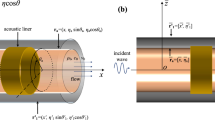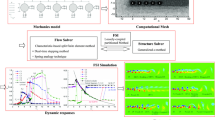Abstract
Efficient numerical method is developed for the prediction of aerodynamic noise generation and propagation in low Mach number flows such as aeolian tone noise. The proposed numerical method is based on acoustic/viscous splitting techniques of which acoustic solvers use simplified linearised Euler equations, full linearised Euler equations and nonlinear perturbation equations as acoustic governing equations. All of acoustic equations are forced with immersed surface dipole model which is developed for the efficient computation of aerodynamic noise generation and propagation in low Mach number flows in which dipole source, originating from unsteady pressure fluctuation on a solid surface, is known to be more efficient than quadrupole sources. Multi-scale overset grid technique is also utilized to resolve the complex geometries. Initially, aeolian tone from single cylinder is considered to examine the effects that the immersed surface dipole models combined with the different acoustic governing equations have on the overall accuracy of the method. Then, the current numerical method is applied to the simulation of the aeolian tones from twin cylinders aligned perpendicularly to the mean flow and separated 3 diameters between their centers. In this configuration, symmetric vortices are shed from twin cylinders, which leads to the anti-phase of the lift dipoles and the in-phase of the drag dipoles. Due to these phase differences, the directivity of the fluctuating pressure from the lift dipoles shows the comparable magnitude with that from the drag dipoles at 10 diameters apart from the origin. However, the directivity at 100 diameters shows that the lift-dipole originated noise has larger magnitude than, but still comparable to, that of the drag-dipole one. Comparison of the numerical results with and without mean flow effects on the acoustic wave emphasizes the effects of the sheared background flows around the cylinders on the propagating acoustic waves, which is not generally considered by the classic acoustic analogy methods. Through the comparison of the results using the immersed surface dipole models with those using point sources, it is demonstrated that the current methods can allow for the complex interactions between the acoustic wave and the solid wall and the effects of the mean flow on the acoustic waves.
Similar content being viewed by others
Abbreviations
- c :
-
Speed of sound
- C d :
-
Coefficient of drag
- C i :
-
Coefficient of lift
- D :
-
Diameter of cylinder
- e :
-
total energy
- e 0 :
-
e+1/2·v 2, stagnation total energy
- h :
-
Enthalpy
- h 0 :
-
h+1/2·v2, stagnation total enthalpy
- I :
-
Turbulence intensity
- k :
-
Turbulent kinetic energy
- L :
-
Turbulence length scale
- ρ:
-
Static pressure
- P :
-
\(p - \mathop {\lim }\limits_{T \to \infty } \int_{ - T}^T {pdt/T} \), fluctuating surface pressure
- Re :
-
u ∞ d/v, Reynolds number
- s :
-
Entropy
- S :
-
Immersed dipole source vectors
- St :
-
Df/u ∞ , Strouhal number
- T :
-
Period of vortex shedding
- t :
-
Time
- u ∞ :
-
Free stream velocity
- u i :
-
Fluid velocity in a cartesian coordinate system
- X i :
-
Cartesian coordinate system
- γ:
-
Ratio of specific heats, γ=1.4 for air
- ν:
-
Kinetic viscosity
- νt :
-
Eddy viscosity
- νeff :
-
ν+νt, effective viscosity
- ρ:
-
Eensity
- ε:
-
Turbulence energy dissipation
- a :
-
Denote the acoustical quantity
- f :
-
Denote the viscous flow quantity
- ∞:
-
Denote the free-stream quantity
References
Bayliss, A. and Turkel, E., 1982 “Far Field Boundary Conditions for Compressible Flow,”Journal of Computational Physics, Vol. 48, pp. 182–199.
Bin, J., Cheong, C. and Lee, S., 2004, “Optimized Boundary Treatment of Curved Walls for High-Order Computational Aeroacoustics Schemes,”AIAA Journal, Vol. 42, No. 2, pp. 414–417.
Blake, W. K. 1986,Mechanics of Flow-Induced Sound and Vibration, Academic Press, INC., Vol. 1 pp. 280–283.
Blevins, R. D. and Ressler, M. M., 1993, “Experimentais on Acoustic Resonance in Heat Exchanger Tube Bundles,”Journal of Sound Vibration, Vol. 164, No. 3, pp. 503–533.
Benhamadouche, S. and Laurence, D., 2003, “LES, Coarse LES, and Transient RANS Comparisons on the Flow Across a tube Bundle,”International Journal of Heat and Fluid Flow, Vol. 24, pp. 470–479.
Bogey, C., Bailly, C. and Juve, D., 2002, “Computation of Flow Noise Using Source Terms in Linearized Euler’s Equations,”AIAA Journal, Vol. 40, No. 2, pp. 235–2432.
Bouris, D. and Bergeies, G., 1999, “Two Dimensional Time Dependent Simulation of the Subcritical Flow in a Staggered Tube Bundle using a Subgrid Scale Model,”International Journal of Heat and Fluid Flow, Vol. 20, pp. 105–114.
Cantwell, B. and Coles, C., 1983, “An Experimental Study of Entrainment and Transport in the Turbulent near Wake of a Circular Cylinder,”Journal of Fluid Mechanics, Vol. 136, pp. 321–374.
Cheong, C. and Lee, S., 2001, “Grid-Optimized Dispersion-Relation-Preserving Schemes on General Geometries for Computational Aeroacoustics,”Journal of Computational Physics, Vol. 174, pp. 248–276.
Chien, K. Y., 1982, “Prediction of Channel and Boundary Layer Flows with a Low Reynolds Number Turbulence Model,”AIAA Journal, Vol. 20, pp. 33–38.
Curie, N., 1955, “The Influence of Solid Boundaries Upon Aerodynamic Sound,”Proc. Roy. Soc. Ser. A, Vol. 231, pp. 505–514.
Ffowcs Williams, J. E. and Hawkings, J. E., 1968, “Sound Generation by Turbulence and Surfaces in Arbitrary Motion,”Philo. Trans. R. Soc. London Series A, Vol. 264, pp. 321–342.
Goldstein, M. E., 2002, “A Unified Approach to Some Recent Developments in Jet Noise Theory,”International Journal of Aeroacoustics, Vol. 1, pp. 1–16.
Gu’enanff, R., Manoha, E., Terracol, M. and Redonnet, S., 2003, “Problem 1: Aeolian Tone Generation From Two Cylinders,” in the Proceeding of 4th CAA Workshop on Benchmark Problems.
Hardin, J. C. and Pope, D. S., 1994, “An Acoustic/Viscous Splitting Technique For Computational Aeroacoustics,”Theoretical Computational Fluid Dynamics, Vol. 6, pp. 323–340.
Hardin, J. C. and Pope, D. S., 1995, “Sound Generation by Flow over a Two-Dimensional Cavity,”AIAA Journal, Vol. 33, No. 3, pp. 407–412.
Hobson, G. V. and Lakshiminarayana, B., 1991, “Prediction of Cascade Performance Using an Incompressible Navier-Stokes Technique,”Journal of Turbomachinery, Vol. 113, pp. 561–572.
Hu, F. Q., Hussaini, M. Y. and Manthey, J. L., 1996 “Low-Dissipation and Low-Dispersion Runge-Kutta schemes for Computational Aeroacoustics,”Journal of Computational Physics, Vol. 124, pp. 177–191.
Kang, D. J., Bae, S.S. and Joo, S.W., 1998, “An Unstructured FVM for the Numerical Prediction of Incompressible Viscous Flows,”Transactions of the KSME, Vol. 22, pp. 1410–1421.
Kiya, M., Arie, M., Tamura, H. and Mori, H., 1980, “Vortex Shedding from Two Circular Cylinders in Staggered Arrangement,”Transactions of the ASME, Vol. 102, pp. 166–173.
Lee, S, 2003, “Cateory 5, Problem 1: Aeolian Tone Generation from Two Cylinders,” in the Proceeding of 4th CAA Workshop on Benchmark Problems.
Lele, S. K., 1997, “Computational Aeroacoustics: A Review,” AIAA Paper 97–0018.
Lighthill, M. J., 1952, “On Sound Generated Aerodynamically-I. General Theory,”Proc. Roy. Soc. Ser. A, Vol. 211, pp. 564–587.
Lockard, D. P., 2003, “A Hybrid Approach to Tandem Cylinder Noise,” in the Proceeding of 4th CAA Workshop on Benchmark Problems.
Seo, J. H. and Moon, Y. J., 2005, “Perturbed Compressible Equations for Aeroacoustic Noise Prediction at Low Mach Numbers,”AIAA Journal, Vol. 43, No. 8. pp. 1716–1724.
Oengoren, A. and Ziada, S., 1998, “An In-Depth Study of Vortex Shedding, Acoustic Resonance and Turbulent Forces in Normal Triangle Tube Arrays,”Journal of Fluid Structures, Vol. 12, pp. 717–758.
Rollet-Miet, P., Laurence, D. and Ferziger, J., 1999, “LES and RANS of Turbulent Flow in Tube Bundles,”International Journal of Heat and Fluid Flow, Vol. 20, pp. 241–254.
Shen, W. Z. and Sorensen, J. N., 1999, “Aeroacoustic Formulation of Low-Speed Flows,”Theoretical Computational Fluid Dynamics, Vol. 13, pp. 271–289.
Shen, W. Z. and Sorensen, J. N., 2001, “Aeroacoustic Modeling of Turbulent Airfoil Flow,”AIAA Journal, Vol. 39, No. 6, pp. 1057–1064.
Tarn, C. K. W. and Web, J. C., 1993, “Dispersion-Relation-Preserving Schemes for Computational Acoustics,”Journal of Computational Physics, Vol. 107, pp. 262–281.
Tarn, C. K. W. and Shen, H., 1993, “Direct Computation on Nonlinear Acoustic Pulses Using High-Order Finite Difference Schemes,” AIAA paper 93–4325.
Tarn, C. K. W. and Dong, Z., 1994, “Wall Boundary Conditions for High-Order Finite Difference Schemes for Computational Aeroacoustics,”Theoretical Computational Fluid Dynamics, Vol. 8, pp. 303–322.
Tarn, C. K. W., 1995, “Computational Aeroacoustics: Issues and Methods,”AIAA Journal, Vol. 33, pp. 1788–1796.
Thomadakis, M. and Leschziner, M., 1996, “A Pressure Correction Method for the Solution of Incompressible Viscous Flows on Unstructured Grids,”International Journal of Numerical Method in Fluids, Vol. 22, pp. 581–600.
Zdravkovich, M. M., 1977, “Review of Flow Interference Between Two Circular Cylinders in Various Arrangements,”ASME Journal, Vol. 99, pp. 618–633.
Zdravkovich, M. M., 1985, “Flow Induced Oscillations of Two Interfering Circular Cylinders,”Journal of Sound and Vibration, Vol. 101, No. 4, pp. 511–521.
Author information
Authors and Affiliations
Corresponding author
Rights and permissions
About this article
Cite this article
Cheong, C., Ryu, J. & Lee, S. Computation of aeolian tones from twin-cylinders using immersed surface dipole sources. J Mech Sci Technol 20, 2292–2314 (2006). https://doi.org/10.1007/BF02916345
Received:
Revised:
Issue Date:
DOI: https://doi.org/10.1007/BF02916345




